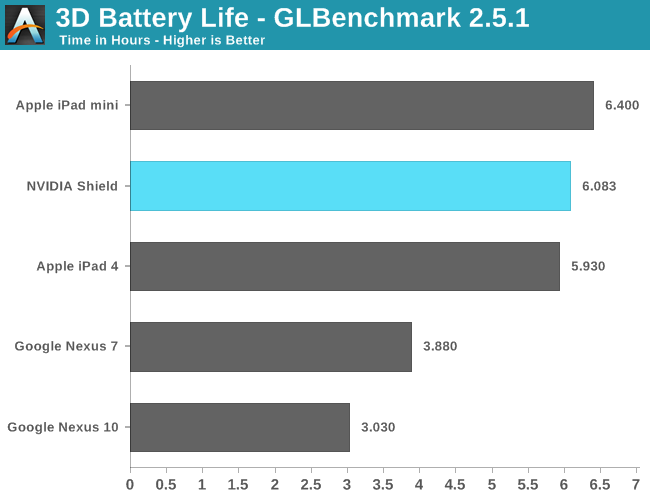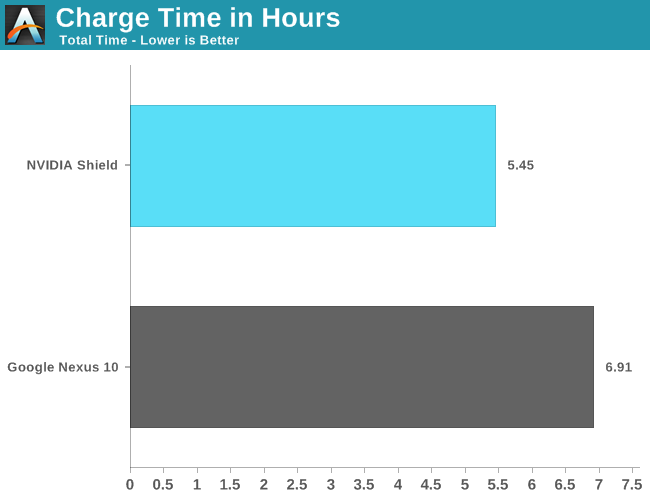NVIDIA Shield Review: At the Crossroads of PC and Mobile Gaming
by Brian Klug on July 31, 2013 12:14 AM ESTBattery Life
NVIDIA's Shield includes a 28.8Wh battery, which is large for a device its size but small compared to what you'd find in a 10-inch tablet for example. The good news is that it only has to power a 5-inch 720p display, which makes the choice of battery size quite nice. Since Shield is a fully functioning mobile device, we put it through our current battery life suite. Normally we'd start with our WiFi web browsing test, but given the target market for Shield I figured starting with our 3D rundown test made the most sense.
Here we have a loop of the Egypt HD benchmark, capped to 30 fps, running on all of the devices with their screens calibrated to 200 nits.

Shield manages just over 6 hours of use on a single charge, putting it up there with some of the best mobile devices we've put through this test. Being able to support 6 hours of locally rendered gaming without plugging in is pretty decent I'd say.
Video decode is also quite important, especially when you consider the use case where Shield acts as a remote display and controller for games rendered on your PC. In that case, the GPU is mostly powered down and only the video decode block is used to display what's being rendered on your PC. Our video playback test might be a good simulation of this use case. Our test remains unchanged from previous tablet reviews. Here I'm playing a 4Mbps H.264 High Profile 720p rip I made of the Harry Potter 8 Blu-ray. The full movie plays through and is looped until the battery dies. Once again, the displays are calibrated to 200 nits:

Tegra 4's video decode engine combined with a tiny 720p display and a 28.8Wh battery results in awesome battery life here - almost 19 hours on a single charge. If you can deal with the small screen, Shield might make for a good companion on long haul international flights just for video playback.
Finally we've got our standard web browsing battery life test:
We regularly load web pages at a fixed interval until the battery dies (all displays are calibrated to 200 nits as always). The differences between this test and our previous one boil down to the amount of network activity and CPU load.
On the network side, we've done a lot more to prevent aggressive browser caching of our web pages. Some caching is important otherwise you end up with a baseband/WiFi test, but it's clear what we had previously wasn't working. Brian made sure that despite the increased network load, the baseband/WiFi still have the opportunity to enter their idle states during the course of the benchmark.
We also increased CPU workload along two vectors: we decreased pause time between web page loads and we shifted to full desktop web pages, some of which are very js heavy. The end result is a CPU usage profile that mimics constant, heavy usage beyond just web browsing. Everything you do on your device ends up causing CPU usage peaks - opening applications, navigating around the OS and of course using apps themselves. Our 5th generation web browsing battery life test should map well to more types of mobile usage, not just idle content consumption of data from web pages.

Once again, excellent battery life from Shield.
NVIDIA ships Shield with a 10W (2.1A) power adapter, capable of completely charging Shield in 5.45 hours:











134 Comments
View All Comments
fr33h33l - Wednesday, July 31, 2013 - link
Nice review as always and good to see Shield and Tegra 4 finally shipping.I am curious though as to what has led to the (so far) low adoption rate of Tegra 4, especially in contrast to the almost performance-wise equivalent Snapdragon 800. Was it just a matter of time-to-market, or was it deal negotiation issues, or as some say (without providing conclusive evidence) that Tegra 4 is inferior to Snapdragon 800 in power efficiency?
Does anyone have more insights (as opposed to unsubstantiated rumors) into this?
Spunjji - Thursday, August 1, 2013 - link
Previously mentioned Amazon reviews for the Toshiba Excite Pro indicate overheating issues and poor battery life. That's not as good as a proper analysis but I'd hesitate to call it unsubstantiated.fteoath64 - Saturday, August 3, 2013 - link
A lot of people are curious about this same question :"Is Tegra 4 is inferior to Snapdragon 800 in power efficiency?". I would agree that it is a yes but not by much. The issue for both chips are that they are overkill (in battery sapping rate) for phone implementation and more suitable for large tablet and console use such as Shield. I think the issue of T4 is its TTM just kills the market opportunity and also the fact that Qualcomm has had multiple solutions to match/counter the old T3 design wins and hence snags them all!. It is a pity for Nvidia but the market is rather brutal due to fierce competition. Even Intel cannot muscle themselves in with the new Atom chip. Not that it is good enough or low priced (huh!). This T4 device at least gives the market some sort of benchmark in comparing its performance in detail over the coming weeks. The S800 tablets are not as forthcoming as we hoped so there is plenty of time to determine some much wanted data.It is interesting to see the SnapDragon S4 Pro chip being used in Nexus 7 and Moto X, new Droid range as well especially when the flagship S600 was doing so well. Is there a radical price difference , I wonder ...
WeaselITB - Wednesday, July 31, 2013 - link
Didn't see it in the review, but I'm curious how well it performs streaming PC game to Shield to HDMI cable plugged into a TV. Cabling get in the way? Problems with battery life in this scenario? How well does the high-res PC compress down to stream to the Shield, then upconvert back to 1080p for the TV? What about transition from sitting on the couch with the cable plugged into the TV, then unplugging the cable to walk into the kitchen, any glitches with transitioning back to the in-device screen?marraco - Wednesday, July 31, 2013 - link
I wish I had a PC client for streaming, so I can run my GTX 670 and play on my laptop/netbookmarraco - Wednesday, July 31, 2013 - link
That would rule out AMD cards for mepandemonium - Thursday, August 1, 2013 - link
I just don't see the point in spending money on a mobile gaming device any more. With all of the smartphones and tablets out there, this is going to be a difficult sell to anyone but the most enthusiastic of fans.Also, my PC is built for gaming and the ecosystem isn't really going anywhere (contrary to popular belief that it's been dying for years and years...). Plus, there's consoles.
It may be awesome, but not for the current day and age. If this came out in 2006, it would've made a killing.
darkhawk1980 - Thursday, August 1, 2013 - link
The only comment I have is that when I played around with this at PAX East 2013, the screen mechanism felt VERY flimsy. I'm not sure if it was because of the fact that these were demo units that were (obviously) very used at that point or what, but I felt like if I closed the screen the hinge would make the screen break in half. It just didn't provide a good feel as it closed, like the hinge was too tight. It reminded me of my MSI GT70's screen at times, where I'm very careful closing it since it is rather delicate.All that aside, it did seem like a good device and was fun to use, but I just don't feel I'd use it as much simply because I enjoy having a tablet for real use.
bertiebond - Thursday, August 1, 2013 - link
so.. its got a screen, it has speakers, it has a a mic, it has wifi..so it just needs 3g and you can stick it next to your ear and start making calls ?D
Spunjji - Thursday, August 1, 2013 - link
SIDETALKIN'